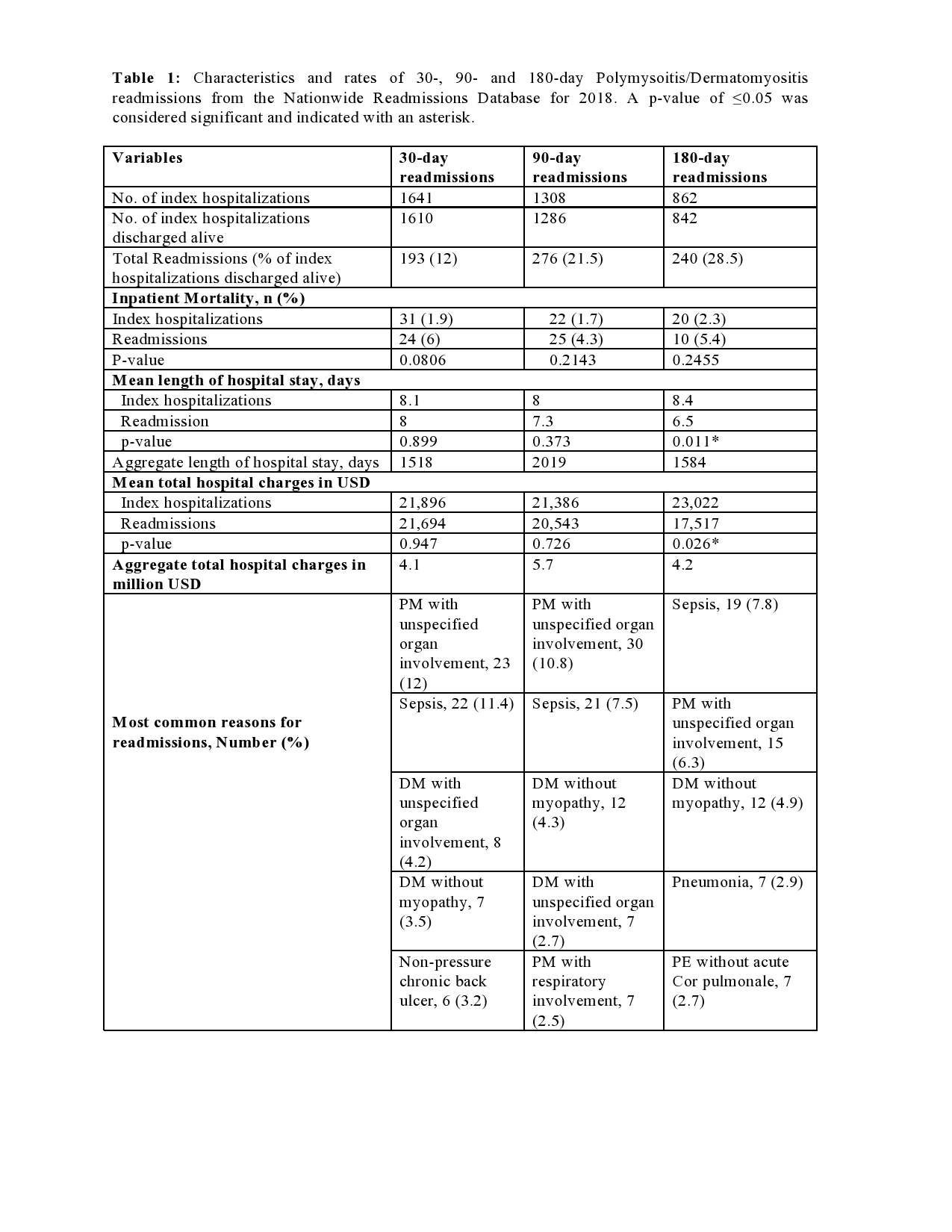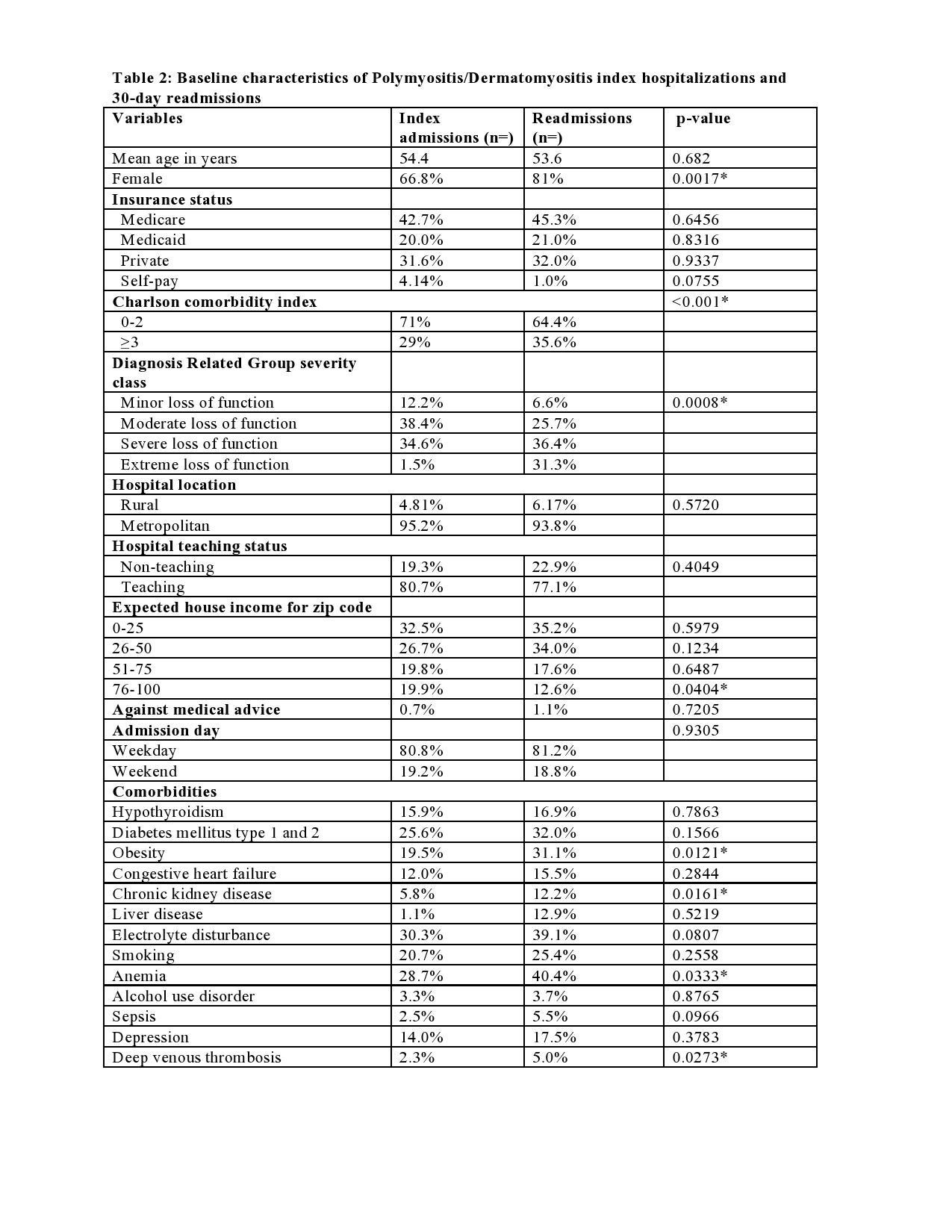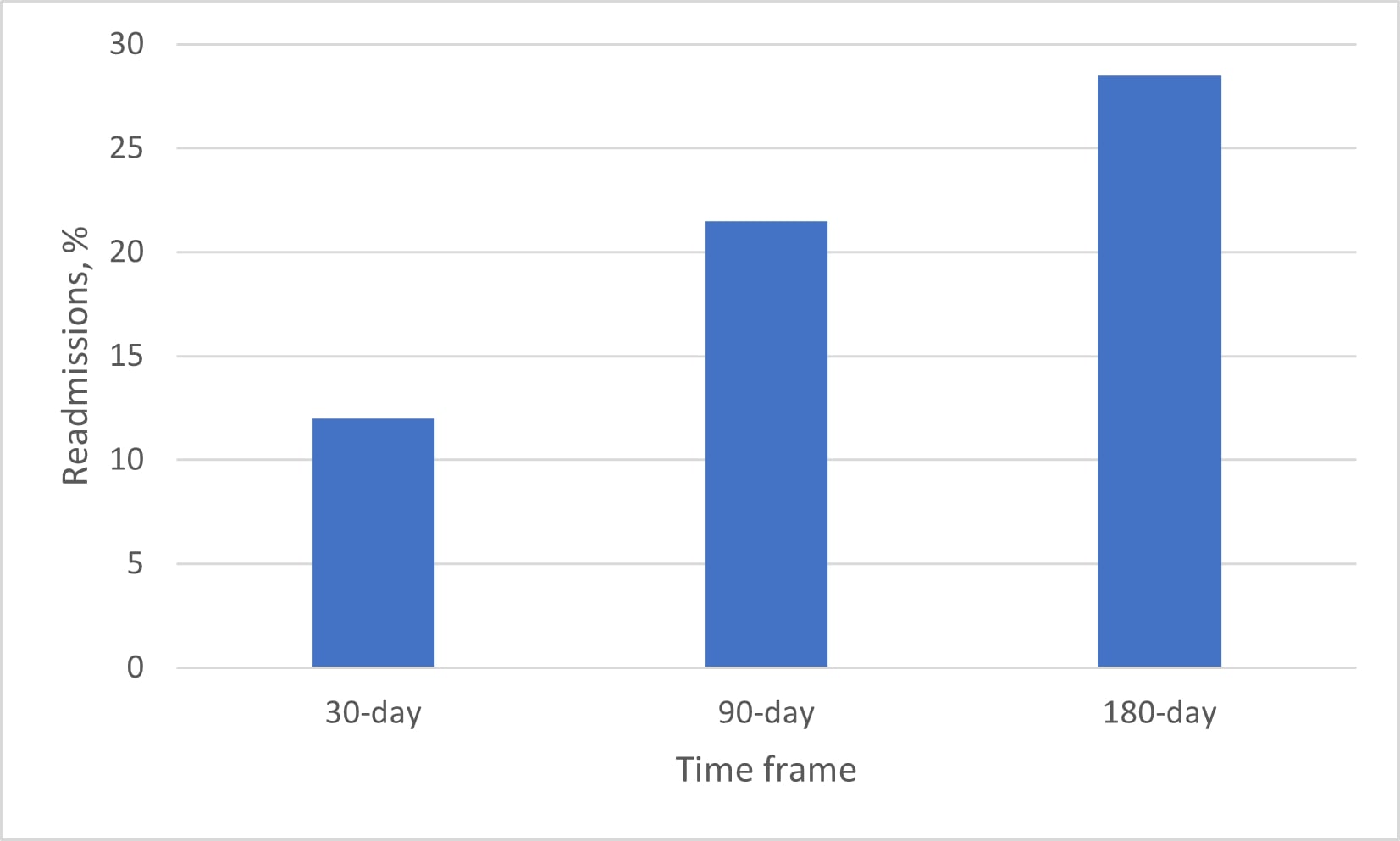Back
Poster Session D
Myopathic rheumatic diseases (polymyositis, dermatomyositis, inclusion body myositis)
Session: (1856–1887) Muscle Biology, Myositis and Myopathies Poster II
1866: Polymyositis/Dermatomyositis Readmissions: Analysis of the Nationwide Readmission Database
Monday, November 14, 2022
1:00 PM – 3:00 PM Eastern Time
Location: Virtual Poster Hall
- AT
Amy Trang, MD
Rush University Medical Center
Chicago, IL, United States
Abstract Poster Presenter(s)
Ehizogie Edigin1, Amy Trang2, Sandhya Shri Kannayiram3, Chinenye Osuorji4, Christopher Hino1, Precious Eseaton5, Solomon Anighoro6, Augustine Manadan2 and Christina Downey7, 1Loma Linda University Health, Loma Linda, CA, 2Rush University Medical Center, Chicago, IL, 3John H. Stroger, Jr. Hospital of Cook County, Chicago, IL, 4Montefiore Medical Center/ Albert Einstein College of Medicine, Bronx, NY, 5University of South Wales, Cardiff, Wales, United Kingdom, 6St. Helens and Knowsley Teaching hospitals NHS Trust, Prescot, England, United Kingdom, 7Loma Linda University Medical Center, Redlands, CA
Background/Purpose: Polymyositis (PM)/ Dermatomyositis (DM) is a chronic immune-mediated myositis characterized by relapses that can lead to frequent hospitalizations. There is a scarcity of national population-based studies on PM)/DM readmissions in the United States (US). In this study, we aim to describe the rates, reasons for readmissions, and characteristics of readmissions for adults hospitalized for PM/DM in the United States (US).
Methods: We analyzed the 2018 Nationwide Readmissions Database (NRD). It includes nested and weighted discharge data for 60% of the total US population from 28 states. These data are stratified in clusters to produce national estimates. The NRD captures admissions on a calendar-year basis (for this study, from January 1 to December 31, 2018) without links to the following or preceding year, which is why index admissions during December, October to December, and July to December were excluded for the 30-, 90-, & 180-day readmission analysis, respectively. Therefore, index hospitalizations from January to November, January to September, and January to June were included in the 30-, 90- and 180-day readmissions analysis, respectively.
We included index hospitalizations for all adult DM/PM patients (aged ≥18 years) with a principal diagnosis of PM/DM using ICD-10 code "M33". The principal diagnosis is the main reason for hospitalization. We excluded elective and traumatic readmissions. Readmission was calculated as the percentage of patients readmitted within a time frame over index hospitalizations that were discharged alive. Using a "rank" command in STATA, the most common specific principal diagnosis of readmissions was outlined. Chi-square tests were used to compare baseline characteristics between readmissions and index hospitalizations. STATA, 16 was used for analysis. Since NRD contains de-identified patient data, Institutional Review Board (IRB) review was not sought.
Results: A total of 1610, 1286, and 842 index hospitalizations with a principal diagnosis of PM/DM, that were discharged alive, were included in the 30-, 90- and 180-day readmission analysis respectively. Among these, 193 (12%), 276 (21.5%), and 240 (28.5%) were readmitted within 30, 90 and 180 days, respectively. PM with unspecified organ involvement and sepsis were the most common reasons for reasons across the 3 timeframes. 30-day readmissions were responsible for an aggregate of 4.1 million US dollars in total hospital cost and 1518 hospital days in 2018. Compared to index hospitalizations, 30-day readmissions were more likely to be females, have higher Charlson comorbidity index scores, severe-extreme loss of function, have a secondary diagnosis of obesity, chronic kidney disease (CKD), anemia, and Deep venous thrombosis (DVT).
Conclusion: Close to a third of PM/DM hospitalized patients are readmitted within 180 days. Readmissions constitute a significant economic burden to the health care system. PM and sepsis are the main reasons for readmissions. Readmissions have a higher comorbidity burden compared to index hospitalizations.
 Abbreviations: PM: Polymyositis, DM: Dermatomyositis, No: Number, USD: United States Dollars, %: Percentage, * Statistically significant,
Abbreviations: PM: Polymyositis, DM: Dermatomyositis, No: Number, USD: United States Dollars, %: Percentage, * Statistically significant,
 Abbreviations: PM: Polymyositis, DM: Dermatomyositis, Median household income: median household income for patient’s Zip code, No: Number, %: Percentage, * Statistically significant
Abbreviations: PM: Polymyositis, DM: Dermatomyositis, Median household income: median household income for patient’s Zip code, No: Number, %: Percentage, * Statistically significant
 Figure 1: Rates of 30-, 90- and 180-day Polymyositis/Dermatomyositis readmissions in the Nationwide Readmissions Database for the year 2018.
Figure 1: Rates of 30-, 90- and 180-day Polymyositis/Dermatomyositis readmissions in the Nationwide Readmissions Database for the year 2018.
Readmission, % was calculated as the percentage of patients readmitted within a time frame over index hospitalizations that were discharged alive.
Disclosures: E. Edigin, None; A. Trang, None; S. Kannayiram, None; C. Osuorji, None; C. Hino, None; P. Eseaton, None; S. Anighoro, None; A. Manadan, None; C. Downey, None.
Background/Purpose: Polymyositis (PM)/ Dermatomyositis (DM) is a chronic immune-mediated myositis characterized by relapses that can lead to frequent hospitalizations. There is a scarcity of national population-based studies on PM)/DM readmissions in the United States (US). In this study, we aim to describe the rates, reasons for readmissions, and characteristics of readmissions for adults hospitalized for PM/DM in the United States (US).
Methods: We analyzed the 2018 Nationwide Readmissions Database (NRD). It includes nested and weighted discharge data for 60% of the total US population from 28 states. These data are stratified in clusters to produce national estimates. The NRD captures admissions on a calendar-year basis (for this study, from January 1 to December 31, 2018) without links to the following or preceding year, which is why index admissions during December, October to December, and July to December were excluded for the 30-, 90-, & 180-day readmission analysis, respectively. Therefore, index hospitalizations from January to November, January to September, and January to June were included in the 30-, 90- and 180-day readmissions analysis, respectively.
We included index hospitalizations for all adult DM/PM patients (aged ≥18 years) with a principal diagnosis of PM/DM using ICD-10 code "M33". The principal diagnosis is the main reason for hospitalization. We excluded elective and traumatic readmissions. Readmission was calculated as the percentage of patients readmitted within a time frame over index hospitalizations that were discharged alive. Using a "rank" command in STATA, the most common specific principal diagnosis of readmissions was outlined. Chi-square tests were used to compare baseline characteristics between readmissions and index hospitalizations. STATA, 16 was used for analysis. Since NRD contains de-identified patient data, Institutional Review Board (IRB) review was not sought.
Results: A total of 1610, 1286, and 842 index hospitalizations with a principal diagnosis of PM/DM, that were discharged alive, were included in the 30-, 90- and 180-day readmission analysis respectively. Among these, 193 (12%), 276 (21.5%), and 240 (28.5%) were readmitted within 30, 90 and 180 days, respectively. PM with unspecified organ involvement and sepsis were the most common reasons for reasons across the 3 timeframes. 30-day readmissions were responsible for an aggregate of 4.1 million US dollars in total hospital cost and 1518 hospital days in 2018. Compared to index hospitalizations, 30-day readmissions were more likely to be females, have higher Charlson comorbidity index scores, severe-extreme loss of function, have a secondary diagnosis of obesity, chronic kidney disease (CKD), anemia, and Deep venous thrombosis (DVT).
Conclusion: Close to a third of PM/DM hospitalized patients are readmitted within 180 days. Readmissions constitute a significant economic burden to the health care system. PM and sepsis are the main reasons for readmissions. Readmissions have a higher comorbidity burden compared to index hospitalizations.
 Abbreviations: PM: Polymyositis, DM: Dermatomyositis, No: Number, USD: United States Dollars, %: Percentage, * Statistically significant,
Abbreviations: PM: Polymyositis, DM: Dermatomyositis, No: Number, USD: United States Dollars, %: Percentage, * Statistically significant,  Abbreviations: PM: Polymyositis, DM: Dermatomyositis, Median household income: median household income for patient’s Zip code, No: Number, %: Percentage, * Statistically significant
Abbreviations: PM: Polymyositis, DM: Dermatomyositis, Median household income: median household income for patient’s Zip code, No: Number, %: Percentage, * Statistically significant Figure 1: Rates of 30-, 90- and 180-day Polymyositis/Dermatomyositis readmissions in the Nationwide Readmissions Database for the year 2018.
Figure 1: Rates of 30-, 90- and 180-day Polymyositis/Dermatomyositis readmissions in the Nationwide Readmissions Database for the year 2018. Readmission, % was calculated as the percentage of patients readmitted within a time frame over index hospitalizations that were discharged alive.
Disclosures: E. Edigin, None; A. Trang, None; S. Kannayiram, None; C. Osuorji, None; C. Hino, None; P. Eseaton, None; S. Anighoro, None; A. Manadan, None; C. Downey, None.

